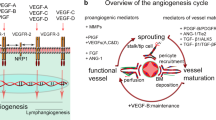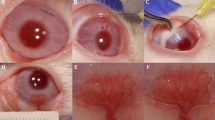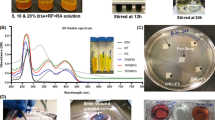Abstract
The purpose of this study was to determine whether rapamycin could inhibit corneal angiogenesis induced by basic fibroblast growth factor (bFGF). Using human dermal microvascular endothelial cells (HDMECs), we examined the effect of rapamycin on cell proliferation and migration, and the expression of vascular endothelial growth factor (VEGF). The rabbit's eye was implanted intrastromally into the superior cornea with pellet containing bFGF for the control group and pellet containing bFGF and rapamycin for the rapamycin group. Bioµgraphically, corneal angiogenesis was evaluated for 10 days after pellet implantation. The neovascularized cornea also was examined histologically. bFGF induced corneal neovascularization was significantly reduced by treatment with rapamycin. Using in vitro model, rapamycin strongly inhibited bFGF induced proliferation, migration, and VEGF secretion of HDMECs. We could observe that the bFGF induced corneal angiogenesis was inhibited by rapamycin in a micropocket rabbit model. The score of neovascularization was significantly decreased in the rapamycin group than in the control group at 10 days after pellet implantation. Histologically, the cornea of rapamycin group also showed much less new vessels than that of control group. Collectively, rapamycin appears to inhibit bFGF induced angiogenesis in a rabbit corneal micropocket assay and may have therapeutic potential as an antiangiogenic agent.
Similar content being viewed by others
Article PDF
Author information
Authors and Affiliations
Rights and permissions
This is an Open Access article distributed under the terms of the Creative Commons Attribution Non-Commercial License (http://creativecommons.org/licenses/by-nc/3.0/) which permits unrestricted non-commercial use, distribution, and reproduction in any medium, provided the original work is properly cited.
About this article
Cite this article
Kwon, Y., Kim, J. Inhibition of corneal neovascularization by rapamycin. Exp Mol Med 38, 173–179 (2006). https://doi.org/10.1038/emm.2006.21
Published:
Issue date:
DOI: https://doi.org/10.1038/emm.2006.21
Keywords
This article is cited by
-
Pre-Seeding of Simple Electrospun Scaffolds with a Combination of Endothelial Cells and Fibroblasts Strongly Promotes Angiogenesis
Tissue Engineering and Regenerative Medicine (2020)
-
Local application of rapamycin reduces epidural fibrosis after laminectomy via inhibiting fibroblast proliferation and prompting apoptosis
Journal of Orthopaedic Surgery and Research (2016)
-
Polylactide-glycoli acid and rapamycin coating intraocular lens prevent posterior capsular opacification in rabbit eyes
Graefe's Archive for Clinical and Experimental Ophthalmology (2009)



